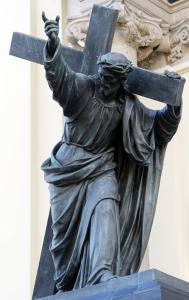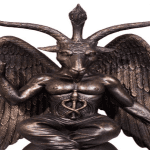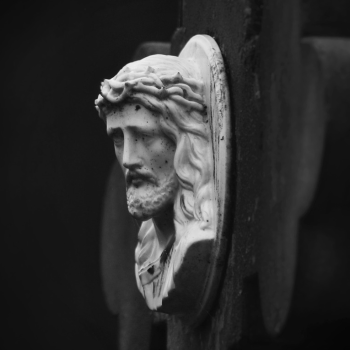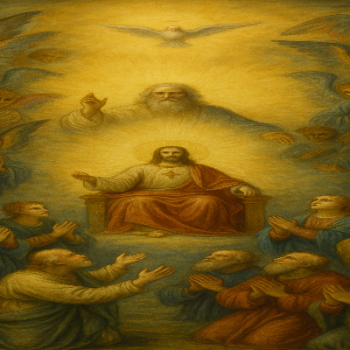
Did God abandon Jesus on the Cross? For those who profess that Jesus is God, one of the most challenging events in the Bible to understand is the cry of dereliction.
In this essay, I will examine Christ’s words and suggest that the most commonly used translation may not be the most helpful in understanding the cry of dereliction. I will then endeavor to explain Christ’s words by placing the cry of dereliction in the light of the hypostatic union.
Specifically, the cry of dereliction refers to the words spoken by Jesus while dying on the Cross. As depicted in both Matthew and Mark’s Gospel, Jesus is said to have cried, “Eli, Eli, lama sabachthani?” which means, “My God, my God, why have you forsaken me?” For some, this statement is evidence that Jesus is not God or that God had somehow abandoned Jesus on the Cross.
As I indicated above, I do not think that the generally accepted interpretation is adequate for understanding the meaning behind the cry of dereliction. First, Christ is quoting Psalm 22. If one, as is generally the case, interprets Psalm 22 in Hebrew, the connotation is of an innocent person baffled by God’s apparent absence. However, as it appears in the Vulgate, a Latin rendering (from the Greek) of the text suggests an entirely different connotation.
In the Vulgate, the relevant language reads this way: “My God, my God, why have you forsaken me? Why are you so far from saving me, so far from my cries of anguish?” I would like to argue that this interpretation of the text has a subtle yet significant difference from the conventional understanding afforded to it by the Hebrew language.
There are three ways in which Christ’s quoting of Psalm 22 can be understood. The first is to take the words as evidence that Jesus is not God. This interpretation is contradicted by incontrovertible scriptural evidence and should be dismissed out of hand.
In the second way, it is the words of one crying out for justice to an absent God. To argue in this way is to conclude that because Christ has taken upon Himself the sins of the world (1 John 2:2), God the Father has allowed the effect of that sin to separate Christ the Son from God the Father. In this sense, the Father has “abandoned” the Son (thought innocent) to the effects of sin (which is death).
The third way that Christ’s words can be understood is to argue that Christ not only takes our sin upon Himself but comes to feel the very human sense that one is in need of mercy and forgiveness. That is to say that Christ experiences the consequence of sin, not only as death but as a separation from God.
In the second interpretation, Christ is an innocent person baffled by the apparent absence of God. In the third interpretation, Christ has become culpable; He has become sin. Moreover, He becomes a sinner who realizes the need for forgiveness.
However, it seems that no matter which interpretation one accepts, one encounters two significant problems. First, if Christ is God, how can God be separated from God? Second, how can God, who is holiness itself, become sin? Said differently, if one of two infinite propositions is true, the other must be false. If God is holy, He cannot be tainted by sin; if God is tainted by sin, He cannot be God. I want to argue that in order to solve the above dilemma, both interpretations must be placed within the greater context of the hypostatic union.
Within Catholic theology, the hypostatic union refers to the existence of two natures – one Divine and one human – in the person of Jesus. The Divine nature is the eternal “whatness” of God and is shared by the three persons of the Holy Trinity. By contrast, human nature is temporal – and, therefore, contingent. It is the “whatness” of human beings and is shared by every human being that has ever existed – including Christ.
In the Incarnation, God takes for Himself a human nature while retaining His Divine nature. Because Christ has a human nature, He experienced all those things common to the human experience: being born, becoming hungry or tired, and even death. Finally, while these two natures existed in one person, to wit, Christ, they remain separated. This separation of natures is critical to understanding how Christ can be God while at the same time being separated from God, as well as to understanding how Christ became sin yet remained the Holy God.
When we speak of Christ being separated from God, we are claiming that Christ – in His human nature – was separated from God because of the sins He had taken upon Himself. It is Christ, therefore, in His human nature that can say, “Why are you (e.g., God) so far from saving me, so far from my cries of anguish?”
In a similar fashion, it is possible to speak of Christ as taking upon Himself the sins of the world while at the same time remaining the Holy God. (See 2 Corinthians 5:21). It is Christ in His human nature that receives the burden of sin; His Divine nature remains untouched. Again, because two natures exist in the one person of Christ, it is logically valid to speak of Christ as human and God.
Finally, the hypostatic union provides a solution to the problem of Divine impassibility. It is logically coherent and consistent to state that God suffered because God became a human being – and to be a human being is to suffer – while maintaining that God in His Divine nature cannot be made to suffer.
A fundamental claim of Catholicism is that God became a human being in order to reconcile human beings with God. This required that God -though entirely holy – take sin upon Himself to reconcile man and God. We can only hope to understand this claim when we incorporate the hypostatic union into our understanding of Jesus of Nazareth.













